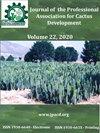Estimation of cladode area of Nopalea cochenillifera using digital images
IF 0.4
4区 农林科学
Q4 HORTICULTURE
Journal of the Professional Association for Cactus Development
Pub Date : 2020-06-20
DOI:10.56890/jpacd.v21i.4
引用次数: 4
Abstract
Determination of photosynthetic area of a plant, leaf or cladode is a fundamental tool in study of transpiration intensity, specific leaf area and leaf area index. The objective of this study was to evaluate Nopalea cochenillifera (L.) Salm-Dyck). cladode area, in a non- destructive way, using digital images and test its relation with the variables: product of length and maximum width and real cladode area through regression models. The design used randomized blocks with three replicates and using the N. cochenillifera forage cactus clone, Giant Sweet. To determine the real cladode area of cactus forage, 432 cladodes in different stages of growth were randomly collected (162 primary cladodes, 127 secondary and 143 tertiary cladodes), all free from damage, disease or pest attacks. All cladodes were photographed with a digital camera (Sony Mark, model DSC-P72) generating a sample of 432 1200 x 2500 pixel digital images of N. cochenillifera cladodes. Linear, gamma and power regression models were adjusted to test the relation between the digital cladode area and the explanatory variables real cladode area and product of length by width. Models were evaluated with the following criteria: Coefficient of model determination, Akaike information criterion, sum of squares of residuals and Willmott index. The power model gave the best performance, with explanatory power higher than 99.5%, while the Willmott index exceeded 0.99. Sum of squares of residuals and Akaike information criterion had lower values. The digital cladode area of N. cochenillifera can be explained by the linear dimensions of cladodes in, and independent of, branching order. The digital cladode area (DCA) of N. cochenillifera can be explained as a function of the power model -DCA = LW0.98Sconsidering the product of length by width (LW) with explanatory variable, and by D-CA = RCA1.002considering real cladode area (RCA) with explanatory variable.利用数字图像估算白桦枝面积
确定植物、叶片或枝状茎的光合面积是研究蒸腾强度、比叶面积和叶面积指数的基本工具。本研究的目的是评估胭脂树(Nopalea cochenillifera(L.)Salm Dyck)。以非破坏性的方式,使用数字图像,并通过回归模型测试其与变量的关系:长度和最大宽度的乘积和真实的枝节面积。该设计使用了三个重复的随机区块,并使用了胭脂虫饲料仙人掌克隆Giant Sweet。为了确定仙人掌饲料的真实分支区域,随机收集了432个不同生长阶段的分支(162个初级分支、127个次级分支和143个三级分支),所有分支都没有受到损伤、疾病或害虫的攻击。用数码相机(Sony Mark,型号DSC-P72)拍摄所有分支,生成432个1200 x 2500像素的胭脂虫分支数字图像样本。对线性、伽玛和幂回归模型进行了调整,以测试数字分支节面积与解释变量真实分支节面积和长度与宽度乘积之间的关系。模型评估采用以下标准:模型确定系数、Akaike信息标准、残差平方和和Willmott指数。幂模型给出了最好的性能,解释力高于99.5%,而Willmott指数超过0.99。残差平方和和Akaike信息准则具有较低的值。胭脂虫的数字分支节面积可以用分支节的线性维度来解释,并且与分支节无关。胭脂虫的数字分支节面积(DCA)可以解释为功率模型的函数——DCA=LW0.98考虑长度与宽度(LW)的乘积和解释变量,并通过D-CA=RCA1.002考虑实际分支节面积和解释变量。
本文章由计算机程序翻译,如有差异,请以英文原文为准。
求助全文
约1分钟内获得全文
求助全文
来源期刊

Journal of the Professional Association for Cactus Development
Agricultural and Biological Sciences-Plant Science
CiteScore
1.10
自引率
33.30%
发文量
10
期刊介绍:
The editors of the Journal of the Professional Association for Cactus Development, are very excited to be a part of the excellent editorial committee and to work together to create the synergism between scientists, growers, legislators, and business people so vital to the development of this industry to serve the people of arid lands.
 求助内容:
求助内容: 应助结果提醒方式:
应助结果提醒方式:


